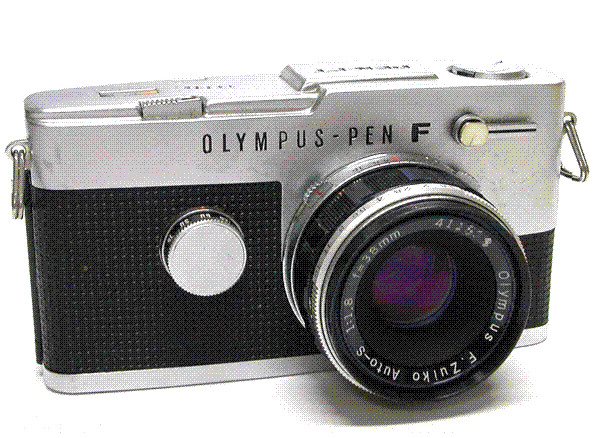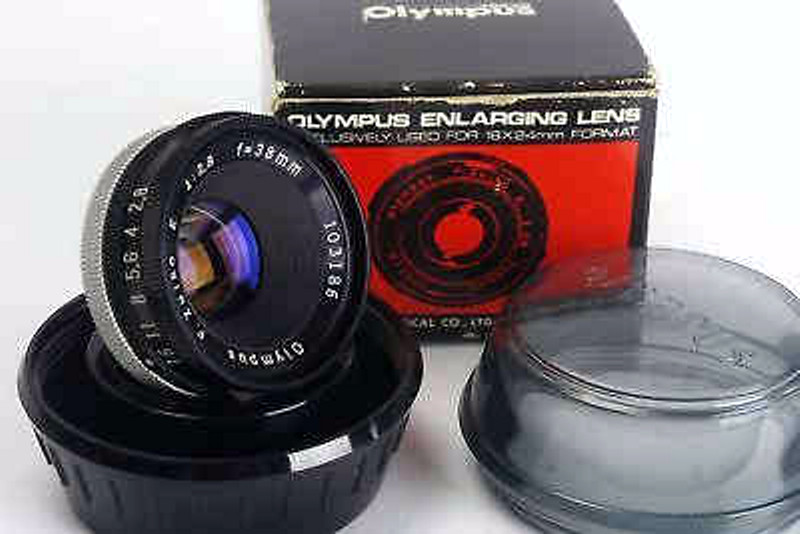
OLYMPUS PEN F CAMERAS

Many think that the Pen F series of cameras is the pinnacle of the half-frame format. In many ways they are right. The Pen F's were the first half-frame SLR's. They introduced many revolutionary features to the photographic world and their popularity convinced all camera manufacturers to make smaller cameras, no matter what the format or camera type.
With the introduction of the Pen F in 1963 (until 1966), Olympus introduced the smallest and lightest, readily-available SLR in the world. (The Russian Narciss 16mm SLR was introduced in 1960) It had a porro prism which avoided the common pentaprism bump on the top of all other SLRs. It also had various interchangeable lens and a unique metal, rotary shutter which allows flash synch at all speeds. After each exposure, the "film-advance" lever was used twice -- once to advance the film and again to cock the shutter. An accessory meter slipped onto the front of the camera (over the shutter speed dial) for non-TTL-metering.
In 1966 (until 1972), Olympus upgraded the Pen F with the Pen FT camera. This added several new features, but most importantly was a behind the lens CDS meter and flash synch. To achieve TTL metering a half-silvered mirror was used. This allowed for more convenience, but resulted in a dimmer view of the subject. A new series of lenses was introduced to take advantage of the TTL capabilities of the camera.
In 1967 (until 1970), Olympus also produced the Pen FV. This was the same as the Pen FT, but with the meter removed. Not only did this reduce the price of the camera, but it increased the brightness of the viewfinder, since the meter in the Pen FT was behind a mirror, removing some of the light from the viewfinder.
Another model, was the rare microscope versions of the Pen F and FT -- which has a special screen for this purpose.
The cameras have a bayonet "Pen" mount and had several available lenses from Olympus. Olympus manufactured the following lenses: 20mm f3.5, 25mm f2.8, 25mm f4.0, 38mm f3.5 macro, 38mm f2.8 (sometimes called the pancake), 38mm f1.8, 40mm f1.4, 40mm f1.2, 60mm f1.5, 70mm f2.0, 100mm f3.5, 150mm f4.0, 250mm f5.0, 400mm f6.3, 800mm f8 mirror, 50-90mm f3.5 zoom, 100-200mm f5.0 zoom. (see complete list below) There were also additional lenses made by several independent lenses manufacturers with the Pen mount.
The list of available lenses was expanded substantially by Olympus Pen F adapters. These allowed lenses from other manufacturers to be directly used on the Pen F-series cameras. Olympus made Canon (FD), Nikon (F), Exacta, Leica (39mm screw), Minolta (MC), Standard Olympus (OM) and Universal-Praktica-Pentax (42mm screw) adapters. There are also Tamron Adaptall, T and T2 mount adapters, and tele-converters available. So the list of usable lenses is endless -- although they will most-likely not couple to the Pen FT metering system, and will most-likely not support automatic apertures.
Olympus also made a wide variety of accessory equipment for the Pen's. The close-up equipment was particularly impressive: various close-up (supplementary) lenses, extension tubes, bellows, focusing rail, slide copier, microscope adapter, endoscope adapter, copy stands, and eyepiece adapters/magnifiers.
Original model with a scripted "F" on the front, and "F" on the top. No built-in meter -- but an accessory, external meter clipped onto the shutter speed dial.
Basically a modified Pen F with a special focusing screen. Says Pen-F on the top.
Improved version with built-in TTL meter. The meter was built-in behind the reflex mirror. A self-timer, and microprism circle in the middle of the viewing screen were added. In addition, the film is advanced and shutter cocked with a single throw of the film advance lever. Came in black or chrome. The camera has "F" on the front, and "FT" on the top. Uses one 625 battery.
This is an FT without the built-in meter. The clip-on external meter could be used. Elimination of the meter dropped the price and made the viewfinder brighter. The camera just says "F" on the front, and "FV" on the top.
Basically a modified Pen FT with a special focusing screen. Says Pen-FT on the top.
Pen lenses came in two styles -- the Pen F and the Pen FT. Not all lenses were available in each series. The series were the same except that the FT lenses were designed to work with the Pen FT's metering system. This system was unique in that it was not based on f-stops, but rather a similar system of numbers (from 0 through 8) that Olympus felt would be easier for users to understand. The Pen F lenses just had f-stops, while the Pen FT lenses had a ring with f-stops on one side -- and o-stops on the other side (Olympus calls these "Through-the-Lens" numbers). The ring can be rotated so that you can use whichever scale you prefer. The meter in the FT gives a readout in o-stops -- in the viewfinder -- which is not of any help at all when uasing the older F lenses.
|
LENS |
f-STOPS |
ELEMENTS |
GROUPS |
ANGLE |
FILTER |
MINIMUM FOCUS |
|---|---|---|---|---|---|---|
|
20mm |
3.5-16 |
7 |
6 |
73 |
43 |
8" |
|
25mm |
2.8-18 |
7 |
5 |
62 |
43 |
10" |
|
25mm |
4.0-16 |
5 |
5 |
62 |
43 |
10" |
|
38mm |
1.8-16 |
6 |
5 |
43 |
43 |
14" |
|
38mm |
2.8-16 |
5 |
4 |
43 |
43 |
31" |
|
38mm |
3.5-22 |
5 |
4 |
43 |
43 |
6" |
|
40mm |
1.4-16 |
7 |
6 |
41 |
43 |
14" |
|
42mm |
1.2-16 |
8 |
6 |
39 |
49 |
14" |
|
50-90mm |
3.5-16 |
10 |
8 |
34-19 |
49 |
59" (5') |
|
60mm |
1.5-16 |
7 |
5 |
28 |
49 |
31" |
|
70mm |
2.0-22 |
6 |
5 |
24 |
43 |
31" |
|
100mm |
3.5-22 |
5 |
4 |
17 |
43 |
59" (5') |
|
100-200mm |
5.0-32 |
12 |
9 |
17-9 |
49 |
67" (6') |
|
150mm |
4.0-22 |
5 |
4 |
12 |
49 |
67" (6') |
|
250mm |
5.0-32 |
5 |
3 |
7 |
58 |
138" (12') |
|
400mm |
6.3-32 |
5 |
4 |
4 |
72 |
197" (16') |
|
800mm |
8.0 |
5 |
5 |
2 |
25.5 |
630" (52') |
Olympus also made an enlarging lens for the series (6 elements in five groups), but it was usable with any half-frame or smaller image. The Olympus F. Zuiko E f 2.8 38mm enlarging lens has a removable 39mm/Leica mount and has a preset diaphragm system with stops from 2.8 - 16. And, of course, enlarging lenses from other lens makers can be used for enlarging Pen images as well. Here is a list.

To return to the main index for the Sub Club click here.
COPYRIGHT @ 1995-2024 by Joe McGloin. All Rights Reserved.